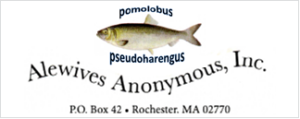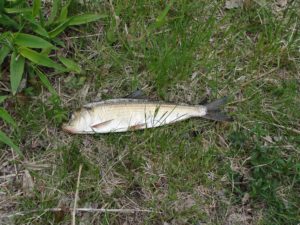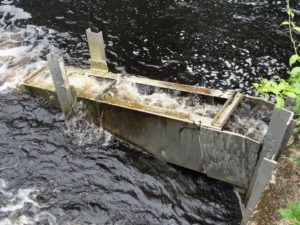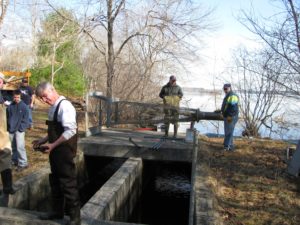
The Herring Helpers
Rochester, Marion and Mattapoisett Massachusetts
Updated November 25, 2023
Alewives Anonymous was founded in November of 1984 by William David Watling, Town of Rochester Herring Inspector at that time.
The Incorporators were:
Gibbs Bray Marion
Hoyle DeMoranville Rochester
Arthur Lionberger Rochester
Elmont Locke Rochester
William Watling Rochester
They incorporated as Alewives Anonymous, Inc., to encourage, promote, and support efforts to preserve and increase the alewife fishery resources in the Mattapoisett River and Sippican River in the towns of Rochester, Marion, and Mattapoisett Massachusetts.
The goals of Alewives Anonymous, Inc. are:
To education the general public as to the importance of the alewife fishery resources and as to general environmental conditions of the Mattapoisett River and Sippican River.
To support scientific research directed towards preserving and increasing the alewife and other anadromous fish resources. (Anadromous fish are fish which migrate up rivers from the ocean to spawn in fresh water.)
To receive contributions & grants, and to raise money by the sale of goods; all contributions, income and proceeds to be applied to the exempt purposes of this Organization as described in the Internal Revenue Code Sec. 501(c)(3) as now in force or hereafter amended.
In recognition of the efforts made toward achieving these goals, on April 29, 1999, at the Annual Meeting of The Coalition for Buzzards Bay (name changed to Buzzards Bay Coalition, May 2011), Alewives Anonymous, Inc. was presented the Guardian Award by Mark Rasmussn, Executive Director.
On Earth Day, April 22, 1993, Paul Keough, Acting Regional Administration, U.S. Environmental Protection Agency Region 1, presented the Environmental Merit Award to Alewives Anonymous, Inc. founder/organizer and then President William D. Watling, “in recognition of Demonstrated Commitment and Significant Contributions to the Environment”.
Sportsmen, fishermen and environmentally concerned individuals and organizations are invited to become members to support the on-going activities by means of annual dues ($10.00) and/or directly participating in the various projects. The Board of Directors meets monthly (except July, August and December) and interested persons are invited to attend. The Annual Meeting is held on the last Sunday in April and features a quahog chowder supper, a recap of the past years activities, election of Board of Directors members and usually a relevant program presented by a guest speaker.
Alewives Anonymous, Inc. has spear-headed projects such as the dredging of a section on the Mattapoisett River from the outflow of Snipatuit Pond to Snipatuit Road, replacing the culverts at Snipatuit Road, and the construction of a permanent fish ladder at the Herring Weir in Mattapoisett.
The organization has, over the years (and continues to do so) cleared the Mattapoisett and Sippican Rivers of blow downs, brush, debris and obstructions, utilizing volunteer help to do so with equipment (canoes, power chain saws, brush cutters, hedge trimmers, winches and various hand tools) provided by the organization.
President Arthur Benner extends an invitation to all sports fishermen and others to assist the organization in maintaining open passage in the two rivers. This will ease the herring’s journey, thereby increasing the number of fish able to make it to the spawning grounds in the two ponds.

Alewives, or herring, are a main food fish for many oceanic fish, whales and shore birds such as the endangered rosette terns. Lobstermen utilize herring as bait in their lobster pots when available. Herring, being smoked or salted, were a staple of the early settlers of our region. Current day human consumption of river herring is mainly the roe (eggs).
The towns of Rochester, Marion and Mattapoisett control and share the alewife fishery resource from the Mattapoisett River and Sippican River jointly through the Tri-Town River Committee. Policy is established at an annual meeting with the Herring Inspectors from the three towns. This is one of only a few herring fisheries in Massachusetts that is shared by multiple towns.
There are two fish ladders located in the Mattapoisett River, which flows from Rochester to Mattapoisett Harbor/Buzzards Bay.
The first one the herring encounter during their Spring migration is in Mattapoisett at the Herring Weir, Route 6 and River Road. This a Denil type ladder of concrete construction that facilitates the herring’s transition from the ocean salt water into the fresh water of the river, an elevation difference of about four feet.
The other ladder is in Rochester, approximately twelve miles upstream from the first ladder, at the headwaters of the Mattapoisett River where the herring reach their destination and make the final transition from the river into Snipatuit Pond (710 +/- acres) where they spawn. This ladder is a traditional concrete weir and pool fishway constructed by Massachusetts Division of Marine Fisheries for the herring to climb the two to three feet in elevation difference between the river and pond.
There are also two fish ladders on the Sippican River, which flows from Rochester to Marion, joining the Weweantic River before reaching Buzzards Bay.
The first one that the herring encounter is in Rochester at Hathaway’s Pond dam (a 22 acre +/- man made pond), a former mill site, approximately three and a half miles from the tidal waters of the Weweantic River. The ladder in use for many years that predates the 1960s was a traditional weir and pool fishway for the herring to climb the four feet elevation difference between the river and pond, the final thirty feet being an enclosed ‘tunnel’ under a road way. This ladder was replaced in 2013 through a project led by property owner Beaton, Inc. and designed by E A Engineering with a ten foot section of aluminum Alaskan steeppass ladder provided by the Massachusetts Division of Marine Fisheries. The ladder, installed in one of the dam’s spillways, was operational for the Spring migration of herring starting in 2014.

Hathaway Pond Fish Ladder
The second fish ladder, also in Rochester, is approximately two more miles upstream where the herring reach their destination and make the final transition from the Sippican River into Leonard’s Pond (a 54 acre +/- man made pond) where they spawn. The original wooden Denil ladder built in 1993 by Massachusetts Division of Marine Fisheries using materials donated by Alewives Anonymous, Inc. was replaced in 2010 through a project led by the Town of Rochester, designed by Tibbetts Engineering Corp. and installed by Marine Tech Inc. with two ten foot sections of aluminum Alaskan steeppass ladder, also provided by the Massachusetts Division of Marine Fisheries. After several changes and adjustments, the ladder was operational for the Spring migration of herring starting in 2013. It facilitates the herring’s transition from the river into the pond, an elevation difference of about four feet.
Both rivers have a herring population comprised of the alewives and the blue back species, (collectively referred to as river herring). The majority of herring in each of these rivers is alewives. The alewives spawn in the quiet waters of the ponds where as the blue backs spawn in the moving waters of the rivers.
Under ideal conditions, river herring have a life expectancy of ten to twelve years. They mature in three to four years and are then ready to make the migration to fresh water to spawn. River herring (unlike salmon that die after returning to their birth river and spawn) return to the ocean after spawning and have the potential to repeat the cycle six or eight times during their lifetime.
An adult herring is ten to twelve inches long. A female will lay approximately 50,000 to 100,000 eggs. Only two or three of these will mature to adults.
In 1883, the weirs on the Mattapoisett River produced an income of $3,214.00 while the school costs were $3,516.00 at that time. Wouldn’t it be great if the sale of herring could support our current school costs?
Historical data from the Marion Town Reports provides the following harvest data:
1906 – 626,000 fish were caught
1907 – 465,000 fish were caught
The quantity of fish harvested has declined steadily since the early part of the twentieth century.
Alewives Anonymous, Inc. has two Smith-Root model 1100 series electronic fish counters to tally the number of herring entering Snipatuit Pond and Leonard’s Pond.

Wire Tunnel and Counting Tunnel Ready for Installation, Snipatuit Pond
Over the years, due to constant cleaning of the rivers and limiting the number of fish caught at the Mattapoisett Herring Weir, the number of herring entering the spawning areas had increased from 40,000 in 1989, the first year of electronic counting, to over 130,000 in 2000. The limits in place prior to the 2006 Massachusetts Division of Marine Fisheries moratorium were (1) not permitting any taking of herring at the Mattapoisett Herring Weir until at least 50,000 fish had entered Snipatuit Pond to spawn, (2) and then limiting the catch to 50 bushels per season and (3) catching on Saturdays only.
In 1996 Alewives Anonymous established an objective of 500,000 herring entering Snipatuit Pond to spawn within eight years (by 2004). It appeared that objective might be realized if the increases in the herring population continued as they were through 2000. Unfortunately, that goal was not reached as a series of steep declines occurred after 2000.
A moratorium against the taking or possession of herring from the Mattapoisett River and the Sippican River, as well as many other rivers in Massachusetts, has been in effect since 2006 per the Massachusetts Division of Marine Fisheries. The counting effort will provide the necessary information to manage a future harvest in the Mattapoisett River, however, continued improvements in the counts are needed to support a sustainable fishery plan and to justify an opening. Once the herring population reaches a point where a sustainable harvest plan can be formulated, filed with Division of Marine Fisheries, and approved, harvesting could be resumed.
For a full report including more picture and graphs, click HERE: AA Librarywebsite2023with pictures
The President of Alewives Anonymous, Inc. is:
Arthur F. Benner
(508) 763-2024
artbenner@comcast.net
Feel free to contact President Benner for further information here:
Alewives Anonymous, Inc.
Post Office Box 42
Rochester, MA 02770


